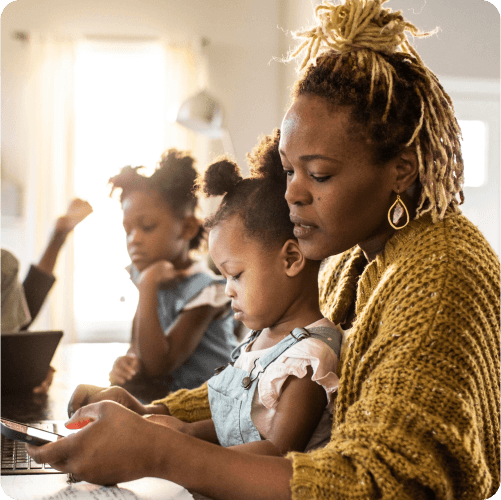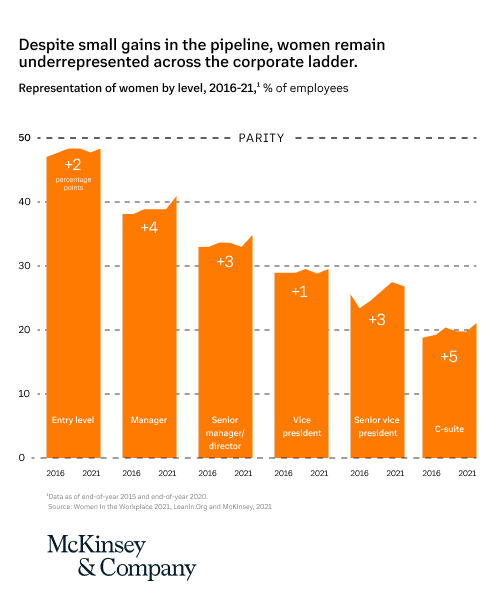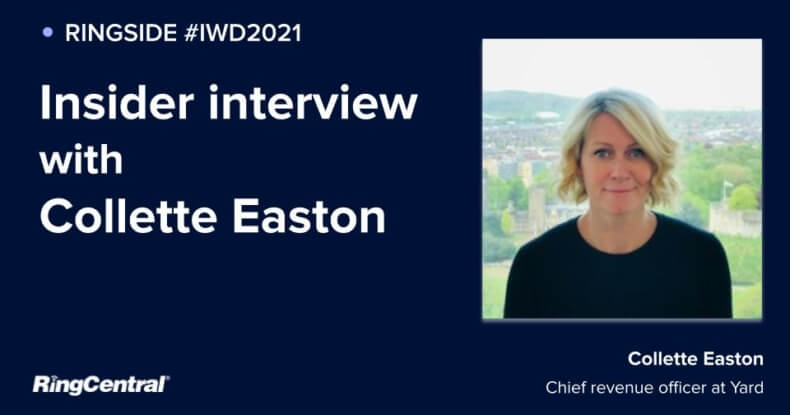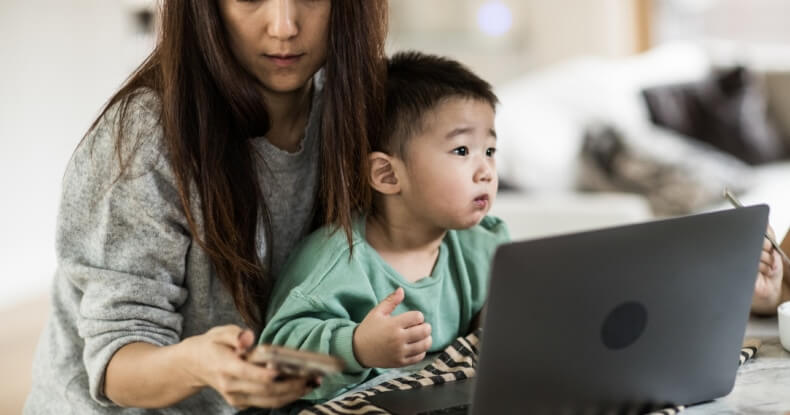International Women’s Day 2022
A 36 -year setback
In the past decade, we’ve seen a shift in the way businesses approach gender inequality. However, we must all do more to make change happen – and that starts with acknowledging gender pay gap data and its implications.
Enter COVID-19.
Prior to the pandemic, it would’ve taken approximately 99.5 years to close the gender pay gap worldwide, according to the World Economic Forum’s Global Gender Gap Report 2020. The current trajectory shows that it will now take 135.6 years to close the gap. The pandemic set women’s equality back 36 years – in only 12 months.
The first step for companies is taking a hard look at their salary data and making fair adjustments. These changes may even require a pay equity audit.
But then what? It’s time to create a truly inclusive work environment. Ensure that employees feel a sense of belonging and are confident their leaders value diverse perspectives.
This task is no small feat and requires a concerted effort at every part of corporate development – from recruitment and onboarding to progression opportunities.
We’re committed to keeping the gender inequality conversation going, and we hope to inspire others to do the same. It’s crucial that we stay up to date on the latest data as we ask ourselves what we are doing to address gender bias and the role it plays in the broader diversity and inclusion narrative.
RingCentral is a proud supporter of International Women’s Day 2022. #BreakTheBias
#ROADTOEQUALITY
RingCentral leaders panel discussion
We asked female leaders throughout RingCentral to weigh in on the importance of International Women’s Day and how they feel supported.
IMPACT OF COVID-19
The pandemic further exposed women’s vulnerability
The coronavirus pandemic exposed considerable social and economic inequalities within an already vulnerable population of women, as female-oriented jobs have been hit the hardest.
Women account for 80% of domestic workers – and 72% of domestic workers lost their jobs due to COVID-19.
Source: UN Women, 2020
Women comprise 39% of worldwide employment but account for 54% of pandemic-based job losses.
Source: McKinsey, 2020
WOMEN’S WELLBEING
Mental health
and the pandemic
The pandemic has had disproportionate effects on women’s mental health and wellbeing. A few statistics that may
surprise you:
- Women are almost twice as likely as men to report that their mental health has become worse since the start of the pandemic (59% of women compared to 30% of men).
- 64% of women with a household income of less than £19,999 say this has got worse, compared to 55% of women with a household income of £40,000 and above.
- Two-thirds of women said staying positive on a daily basis has become more difficult since the last lockdown. Just over one-third of men (36%) reported the same.
- 65% of women are finding social isolation hard to cope with, compared to 33% of men.
- Nearly half of women (48%) reported that their nutrition has declined since the start of the pandemic – approximately 26% of men said the same.
- Data from the first wave of the pandemic (November 2020) showed that women with childcare duties reported higher levels of anxiety than men with these responsibilities.
The difference in men’s and women’s health and wellbeing during the pandemic is yet another gender gap that needs to be closed. It’s time we #BreakTheBias.
GENDER EQUALITY 101
What is the gender pay gap?
Before we dig deeper into the findings, let’s start by looking at exactly what the gender pay gap is. Because there’s a stark difference between “pay gap” and “equal pay.”
The pay gap is the percentage difference between average hourly earnings for men and women. Equal pay, on the other hand, is a legal requirement that all genders should be paid the same.
A company might have a gender pay gap if the majority of male employees are in top jobs, even if its male and female employees are paid equally for similar roles.
The most recent Global Gender Gap Report states, “significant data availability limitations prevent reflecting a non-binary view of gender gaps that covers the full spectrum of gender identities. As such, the index and the analysis remain focused on benchmarking progress on disparities between women and men.”
However, research from YouGov by LinkedIn shows that there's a 16% pay gap between LGBT+ professionals and their heterosexual colleagues. That's £6,703 less every year.
When talking about the wage gap for women, it’s important to note that wages vary significantly by race and ethnicity, not just gender. According to recent research from the London School of Economics, black women were found to be 6.1% less likely than white women to be in the top ten percent of income.
CONTRIBUTING FACTORS
Why does the gender pay gap still exist?
Although a number of factors have led to the gender wage gap that currently exists, the Organisation for Economic Co-operation and Development (OECD) suggests there are two main reasons: “glass ceilings” and “sticky floors.” Now we can add COVID-19 to the list.

Glass ceilings
“Glass ceilings” refer to obstacles that stop women from progressing. Most “glass ceiling” situations involve a woman’s familial responsibilities. Women are often expected to care for young children and elderly relatives.
Because of these expectations, women are more likely to work in part-time roles, which are often lower paid and provide few opportunities for progression. For example, a woman may not apply for a promotion that has high demands or time commitments because she can’t find reliable childcare. OECD findings suggest that “glass ceilings” account for approximately 60% of gender wage gaps.

Sticky floors
“Sticky floors” are disadvantages women face throughout their careers. They include societal norms, stereotypes and discrimination that holds women back in their professions.
An example of a “sticky floor” is a manager offering a woman a lower starting salary than her male counterpart because the manager assumes that women are less competent or less qualified for the position – which is a legal “equal pay” issue. “Sticky floors” account for approximately 40% of gender wage gaps.

The pandemic
The pandemic only magnified gender inequality at work with shelter-in-place orders. These stay-at-home policies disproportionately affected women – particularly single mothers and women of colour.
Following the first year of the pandemic, women in the workforce were at a 33-year low. As women choose to go back to work, many will experience an “unemployment penalty” – a wage cut that can occur when employees take absences from their jobs.
Contributors to the gender wage gap
“Glass ceilings” account for approximately 60% of gender wage gaps.
“Sticky floors” account for approximately 40% of gender wage gaps.
Following the first year of the pandemic, women in the workforce was at a 33-year low.
THE GENDER PAY GAP
It’s a global problem
Around the world, women earn on average 32% less than men for the same work, according to 2021 Global Citizen research. Data prior to the pandemic showed that women earned on average 23% less than men, globally.
But the pay gap doesn’t provide a complete picture of women’s financial inequality. Other factors, like the lack of women in leadership positions, make it increasingly difficult to close the Economic Participation and Opportunity index gap. As it stands, women represent only 27% of all managerial positions worldwide – as a result, the World Economic Forum estimates it will take 267.6 years to close this economic gap.
Closing the gap benefits everyone
If women in the workforce were paid equally to comparable men – same age, same level of education, same workload – the poverty level for working women would be cut by more than 40%, according to 2021 Institute for Women’s Policy Research.
WOMEN IN THE WORKPLACE
Progress has been marginal since 2016
Women continue to experience a “broken rung” at the first step to management. McKinsey’s Women in the Workplace 2021 report indicates that for every 100 men promoted to entry management positions, only 86 women receive the same opportunity. Because of this, men significantly outnumber women in the talent pool. Therefore, men receive more offers to be promoted up the corporate ladder. This underrepresentation of women at the entry management level likely explains the slow progression of women being hired to C-suite positions.
Graph source: Mckinsey.com

MOVING FORWARD
A look on the bright side
Many organisations are committed to equality and making strides to even things out.
Our CSuite is now 25%. On top of this, 25% of our Board of Directors and 32% of our VPs are women. Across the company, 37% of all employees are female.
We know there’s still a long way to go, but we’re happy to have increased our representation of women in top positions.
REPRESENTATION MATTERS
The business value of gender diversity
The greater the diversity in representation within a company – particularly women in top positions – the more likely it is to succeed against its competitors. McKinsey research shows that organisations with more than 30% female executives were more likely to outperform businesses with only 10% to 30% female executives. The 2020 research report from McKinsey also shows that organisations that rank in the top quartile for gender diversity among executives were 25% more likely to achieve above-average profitability than businesses in the bottom quartile.
CULTURAL IMPACTS
How flexible working is helping to close the gap
We know the female talent pipeline starts to shrink at the first step into management. One of the key reasons for this is caretaking. Research shows that mothers’ employment rates and hours of paid work fall by 22% and 33% on average when children arrive.
Well-designed flexible working is the key to enabling women to continue to participate in the boardroom, from wherever they may be. Normalise flexible working by boosting its use on all teams and levels of seniority.
GUNJAN AGGARWAL
A message from our Chief People Officer
According to the World Economic Forum, the pandemic reversed efforts to close the gender gap by 36 years. It’s a bleak picture. Now is the time to address the challenge and create opportunities where we can.
Last year, I spoke about fostering strong cultures that are diverse and inclusive. I continue to work with my teams on this.
Some of the initiatives supporting the diversity of RingCentral talent are our RingCentral SaaSy Women Employee Resource Group, Women & Allies Leadership Coalition, Transition N2 Tech hiring initiative and our HBCUs L.E.A.D. programme for college students. For international Women’s Day specifically, we will be fundraising for the charity organisation Global Fund for Women and The Girls’ Network.
Our C-suite is now made up of 27% women. On top of this, 25% of our Board of Directors and 32% of our VPs are women. Across the company, 37% of all employees are female. There’s a long way to go, but these figures show we’re on that journey.
Perhaps my biggest learning from this time is that with every challenge comes an opportunity. Everything that’s happened has given us a chance to forge an even better, and more equal, environment for our employees. It’s up to us to take that chance.
Looking at the year ahead and even beyond that, we’ll continue to take these chances to strengthen our inclusive culture. If you’d like to talk about how we can make it better together, please get in touch.
YOUR IMPACT
Small wins that have a big impact
Here’s how companies can rethink their inclusion strategies to specifically challenge the gender pay gap.

1. Challenge the likeability penalty
When a man is successful, his peers often like him more; when a woman is successful, both men and women often like her less. This is explained in the Heidi vs. Howard study. This trade-off between success and likeability creates a double-bind for women. If a woman is competent, she does not seem nice enough, but if a woman seems really nice, she is considered less competent. Listen for the language of the likeability penalty, particularly when making hiring decisions and evaluating performance. When you hear biassed language – such as “bossy,” “pushy,” and “shrill” – request a specific example of what the woman did and then ask, “Would you have the same reaction if a man did the same thing?”

2. Get more out of meetings
This starts in school, where girls get less airtime and are interrupted more, even by the most well-intentioned teachers. If you watch men and women at the same level, you will notice that more of the men sit in the front seats, while women tend to gravitate toward the end of the table and edge of the room – away from positions that convey status. Without full participation in meetings, you cannot tap everyone’s skills and expertise, and this undermines team outcomes. If a female colleague is interrupted, interject and say you’d like to hear her finish. Be aware of “stolen ideas” and look for opportunities to acknowledge the women who first proposed them.

3. Share the office “housework”
Women take on more “office housework” – service and support work such as taking notes, organising events, and training new hires. These tasks steal valuable time away from core responsibilities and can keep a team member from participating fully. The person taking diligent notes in the meeting almost never makes the killer point. In keeping with deeply held gender stereotypes, people tend to expect help from women but not from men, so when women do favours at work, they earn no points for doing so. Audit who’s doing service work and make sure it’s distributed evenly between women and men – and that women are not doing additional work without additional reward.

4. Measure inclusion at every level
Measurement drives accountability; accountability drives behaviour change. We recommend you measure the representation of women at all levels of your organisation, not just the overall female/male split when hiring. You can also measure the percentage of women compared to men being promoted annually. Finally, create programs that enable more women to be considered for the first step into management and combat data that suggests there is not typically equal opportunity here.
WHAT OTHERS ARE SAYING — #IWD2022
Quotes for International Women’s Day
We're committed to making a real difference. That's why we match 100% of all employee donations made to nonprofits through RCause. We're especially pleased to offer our donation matching for excellent organisations like Global Fund for Women and The Girls' Network who are working to bridge the gap for women and girls worldwide.
Global Fund for Women is one of the world's leading foundations for gender equality, standing up for the human rights of women and girls.
The Girls' Network aims to inspire and empower girls from the least advantaged communities by connecting them to a mentor and a network of professional female role models. This year, we’ll be raising funds for the network through a virtual talent show.





